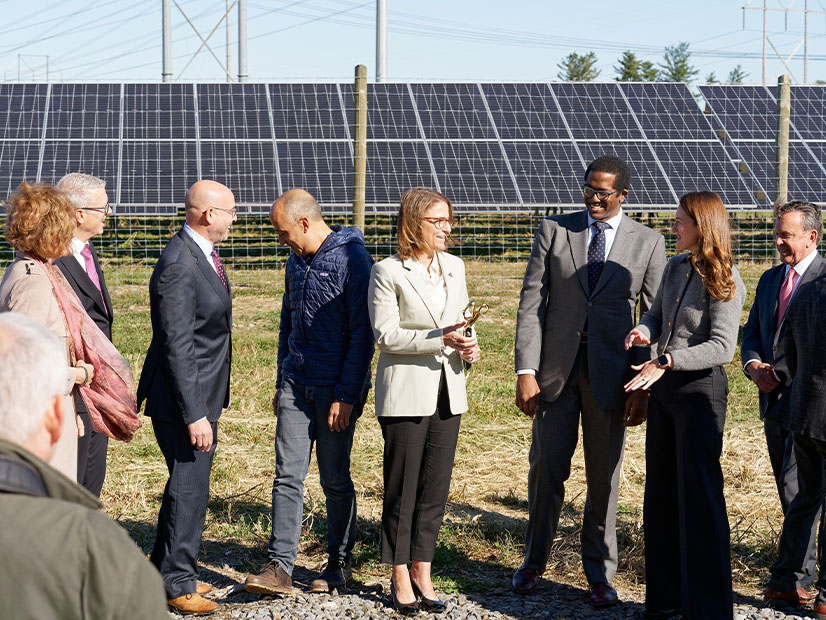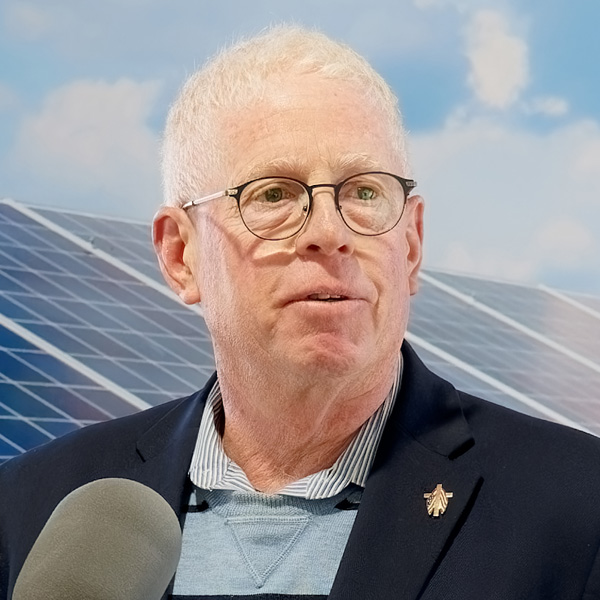
NEW SCOTLAND, N.Y. — Small-scale solar arrays in New York have surpassed 6 GW of capacity, meeting a milestone 2025 goal more than a year early.
It’s a bright spot in a state whose energy transition has been progressing more slowly than hoped.
Leaders of the transition and some of those helping to carry it out gathered at a new 5.7 MW solar farm Oct. 17 to celebrate the occasion and advocate for the addition of many more megawatts to follow.
The site itself is easy enough to reach, a smooth ride on main roads to the town of New Scotland, not far from the state offices where renewable energy policy is written, regulated and facilitated.
But the journey to reach the milestone achieved on this site was much longer: 235,803 distributed solar projects of every stripe had to be completed in every corner of the state before this one could push the combined nameplate capacity above 6 GW.
An uncounted additional number of projects dropped out of the pipeline along the way, just as utility-scale projects have seen high rates of contract cancellation in New York.
So why is distributed solar exceeding expectations by adding emissions-free capacity to the grid a few dozen kilowatts at a time? While multi-megawatt projects are lagging so badly the state is likely to miss a key 2030 renewables target codified in its climate law?
State support has allowed an ecosystem supporting distributed solar to grow to scale in New York, said Doreen Harris, president of the New York State Energy Research and Development Authority, one of the main architects and managers of the state’s energy transition.
These same policies send clear market signals that small solar is wanted and will be supported. In a telling indicator, New York — an expensive state with limited sunshine — is the nation’s leader in installed community solar capacity.
Smaller projects are nimbler, said Noah Ginsburg, executive director of the New York Solar Energy Industries Association. They face the same obstacles as large projects, with endless variations across hundreds of local permitting entities, but they can move and adjust quickly enough to not die on the vine.
“The timeline for getting a [distributed] project from idea to up and running, we’re talking three years,” he said. “You can navigate choppy waters and get projects over the finish line on that kind of timeline. And I just think New York has developed a really successful model.”
The 6 GW emerged with steady assistance from the state, including the $3.3 billion NY SUN initiative. The state estimates an additional $9.2 billion in private-sector investment has been a result.
The New Scotland project checks another box on the state’s list of priorities: It is one of the first community solar farms to participate in the Solar for All program. The savings achieved through its operation will be funneled to low-income ratepayers.
Moving Forward
Officials and guests at the ceremony spoke afterward to NetZero Insider about what went into reaching the 6 GW milestone and what comes next.
David Sandbank, NYSERDA’s vice president of distributed energy resources and transportation, said the state categorizes distributed solar as everything from residential rooftop arrays producing a few kilowatts on their best day to several-acre arrays rated at several megawatts, like the new one in New Scotland.
The cutoff is 5 MW for projects quantified in alternating current and a little more than 7 MW for those quantified in direct current.
“So if you talk in DC … I’d say the average home project is about 7 KW in this state. So 7 KW to 7 MW,” Sandbank said.
The next milepost is 10 GW of distributed solar by 2030. NYSEIA earlier this year called for kicking that up to 20 GW by 2035.
Distributed solar is a mainstay of NYSEIA’s 235 member companies, and obviously a priority for Ginsburg, but he says renewables are needed at every scale.
“My view on it is that for the state to hit its clean-energy goals, we need to accelerate utility-scale deployment,” he said.
The problem, Ginsburg said, is that some people overlook the contributions of small solar as they focus on major projects that would provide dozens or hundreds of megawatts.
“So, I try to remind people, 93% of the solar that’s up and running in New York is distributed scale; 6 GW is nothing to sneeze at,” he said.
Rory Christian, chair of the state Public Service Commission, said this fact is not lost on policymakers. It also is clear that 6 or 10 or 20 GW of solar does not by itself allow fossil-fuel generation to be retired — solar’s capacity factor is too low in New York, particularly during the short and often cloudy winter days.
There are simultaneous efforts to develop other forms of emissions-free generation and storage to backstop intermittent solar and wind; to anticipate transmission and distribution needs and address them proactively; and to begin managing the other side of the equation — demand.
So while 6 GW of distributed solar is an achievement to be celebrated, it is a mile marker rather than a finish line, a piece of a strategy that still is being planned out.
“We know there’s a gap. It’s documented in the [state climate law]. We are working to address that gap, and we recognize that we need to do more, and so we have the plans in place to do more, and we’re figuring that out as we go,” Christian said.
“What are those dispatchable emissions-free resources? What will those be? How will those function? Where do we put them? We’re looking at that right now.”
Electric utilities are working on their part of the equation.
The new solar farm sits near a National Grid substation and almost beneath some of its transmission lines.
That proximity helps with development, but there are many other factors that go into siting and system planning, said Brian Gemmell, National Grid’s chief operating officer for electric. “It’s all about making [sure] that the reliability is there, the resilience, the infrastructure is appropriately sized for the project.”
The utility is investing billions of dollars in dozens of projects to make its upstate New York network ready for more renewables expected to be built there.
Hurdles to Clear
Dan Berwick, CEO of New Leaf Energy, the New Scotland project developer, said solar development is not an easy proposition in New York. Permitting is hard, interconnection is harder, costs are higher than in other states and profits are lower. But New Leaf keeps at it, he added, and now has nearly 200 projects in development statewide.
State leadership is committed to making renewable development happen, and that makes it possible to clear those hurdles.
“We keep investing, even though it’s tough, because New York has a unique winning formula. New York’s political leadership sets big, clear, bold goals, and then NYSERDA and the Department of Public Service execute on those goals,” Berwick said.
“No other state has a NYSERDA, and that is why there’s no other state where we will develop projects and make substantial investments in projects based only on what a state government says it will do, as opposed to what it has already done. That’s unique, and it’s very powerful.”
The area is a blend of suburban and rural, light industrial sites and homes mixing with fields and woods. It is a quick drive from the state Capitol, yet far enough removed from the city that some people expect to see trees and distant hills rather than solar panels. A nearby apple orchard is a longstanding agritourism destination.
New Scotland Town Supervisor Douglas LaGrange spoke about the balance struck as the project moved through its yearslong development and review.
New Scotland is one of New York’s Climate Smart Communities, he said, and wants to do its part to advance climate protection goals.
“It started years ago when … we saw the opportunity to bring solar into the town and accommodate it, but we wanted to balance it with the beauty of the town,” LaGrange said. “It’s a beautiful area. And there are those that might suggest that solar arrays aren’t the prettiest things in the world, but we came to a point where we could balance both.”
He added: “This is a perfect example of that all coming together.”
Steven and Wendy Burke have owned the 27-acre site for more than 20 years but never developed it themselves. A local farmer cut hay from the portion that was not wooded.
The couple support renewable energy development; she drives an electric vehicle. When they decided to lease their land for solar development, they got some friction from a few neighbors, but it was less about the panels than the effect of the panels.
“There was a couple neighbors that had [objected] in the beginning, not knowing what it was going to look like,” he said.
“Or had questions and how things were going to be done,” she continued, “and wanted to make sure that it wasn’t going to be unsightly, that there was going to be proper screening, that it was going to be maintained properly, which were valid questions, and the town was able to answer those questions.”
One of the more frequent questions, the Burkes and LaGrange both said, was whether the array would be visible from the landmark Thacher Park overlook atop a 700-foot escarpment two miles away.
It is not, thanks to the contour of the hill. And the line of mature trees at the solar farm’s perimeter blocks passing motorists’ view of the panels, save for a gap the driveway runs through.
A line of saplings transplanted inside will close that gap in a few years.
Ginsburg said this is a winning approach.
“I think the reality is that as a species, we are resistant to change, but ultimately we need clean energy in our state,” he said. “Projects like this can be built in a way that’s aesthetic and that’s beneficial.”








